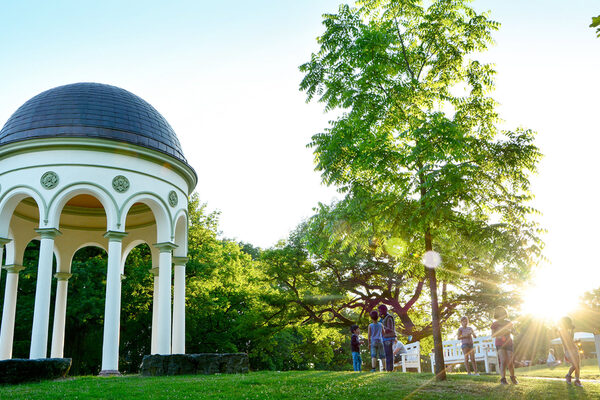History Northeast - Coveted villa districts through the ages
Urban development in today's Wiesbaden-Nordost district only began in the 19th century. Until then, there were only isolated buildings, such as Hof Geisberg, built in 1788.
Green villa district
The planned development began in 1818 with the slope side of Taunusstrasse, which closed off the historic pentagon. In the 1840s, parallel to the construction of the Paulinenschlösschen, the first villas were built on Sonnenberger Strasse and Bierstadter Strasse. These areas quickly became the preferred residential area of Wiesbaden's wealthy society. The park-like gardens formed the green quarter of the city.
Expansion and development of new residential areas
The town continued to grow. From the 1860s, the development north-west of Röderstraße gathered pace and the expansion towards Geisberg also took shape. Close to the Russian Orthodox church, also known as the Greek chapel, which was built between 1847 and 1855, a further landscape of villas grew up until the First World War. The Nero Valley, which was developed as a residential area at the beginning of the 20th century, became one of the most sought-after districts in Wiesbaden.
Historical landmarks and tourist attractions
With the opening of the Nerobergbahn in 1888, which made it easier to access the Neroberghotel, one of Wiesbaden's most important tourist attractions developed. The Neroberg and the Opelbad, which opened in 1934, are still popular destinations for people from Wiesbaden and all over the world.
From the fairground to film and media history
Another historically significant place in Wiesbaden-North-East is the Unter den Eichen area. When the Allied occupation troops stationed here since the First World War withdrew, a mass festival for the "Rhineland Liberation" took place here in 1930. From 1944 to 1945, the site was home to a satellite commando of the SS Hinzert special camp. Today, the Unter den Eichen concentration camp memorial commemorates this dark time. After the war, the film and television industry moved in here. The ZDF was based here from 1964 to 1984.
Post-war buildings and historical relics
After the Second World War, new buildings such as the Federal Criminal Police Office, which opened in 1953, and smaller projects such as the Brockhaus publishing house on Leberberg contributed to further urban development. The Platte hunting lodge, built between 1823 and 1826 and destroyed in 1945, was historically restored. The ruins are a testimony to the town's history and are now a popular venue for events. It is located on the edge of the city forest on the historic "Platea", a road that has always connected the Rhine with Limburg.
Historical highlight
The meadow valley of the Schwarzbach stream was transformed into an English landscape garden in 1897/1898 - the Nero Valley Park.
Are you interested in the history of Wiesbaden?
The city encyclopedia gives you exciting insights into our city's history.
